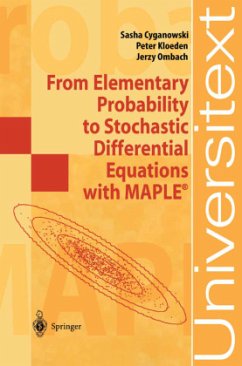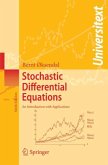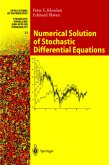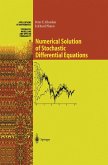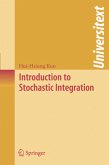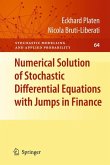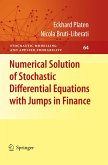The authors provide a fast introduction to probabilistic and statistical concepts necessary to understand the basic ideas and methods of stochastic differential equations. The book is based on measure theory which is introduced as smoothly as possible. It is intended for advanced undergraduate students or graduates, not necessarily in mathematics, providing an overview and intuitive background for more advanced studies as well as some practical skills in the use of MAPLE in the context of probability and its applications. As prerequisites the authors assume a familiarity with basic calculus and linear algebra, as well as with elementary ordinary differential equations and, in the final chapter, simple numerical methods for such ODEs. Although statistics is not systematically treated, they introduce statistical concepts such as sampling, estimators, hypothesis testing, confidence intervals, significance levels and p-values and use them in a large number of examples, problems and simulations.
Measure and integration wereonceconsidered,especially by many ofthe more practically inclined, to be an esoteric area ofabstract mathematics best left to pure mathematicians. However,it has become increasingly obvious in recent years that this area is now an indispensable, even unavoidable, language and provides a fundamental methodology for modern probability theory, stochas tic analysis and their applications, especially in financial mathematics. Our aim in writing this book is to provide a smooth and fast introduction to the language and basic results ofmodern probability theory and stochastic differential equations with help ofthe computer manipulator software package MAPLE. It is intended for advanced undergraduate students or graduates, not necessarily in mathematics, to provide an overviewand intuitive background for more advanced studies as wellas somepractical skillsin the use of MAPLE software in the context of probability and its applications. This book is not a conventional mathematics book. Like such books it provides precise definitions and mathematical statements, particularly those based on measure and integration theory, but instead ofmathematical proofs it uses numerous MAPLE experiments and examples to help the reader un derstand intuitively the ideas under discussion. The pace increases from ex tensive and detailed explanations in the first chapters to a more advanced presentation in the latter part of the book. The MAPLE is handled in a sim ilar way, at first with simple commands, then some simple procedures are gardually developed and, finally, the stochastic package is introduced.
Measure and integration wereonceconsidered,especially by many ofthe more practically inclined, to be an esoteric area ofabstract mathematics best left to pure mathematicians. However,it has become increasingly obvious in recent years that this area is now an indispensable, even unavoidable, language and provides a fundamental methodology for modern probability theory, stochas tic analysis and their applications, especially in financial mathematics. Our aim in writing this book is to provide a smooth and fast introduction to the language and basic results ofmodern probability theory and stochastic differential equations with help ofthe computer manipulator software package MAPLE. It is intended for advanced undergraduate students or graduates, not necessarily in mathematics, to provide an overviewand intuitive background for more advanced studies as wellas somepractical skillsin the use of MAPLE software in the context of probability and its applications. This book is not a conventional mathematics book. Like such books it provides precise definitions and mathematical statements, particularly those based on measure and integration theory, but instead ofmathematical proofs it uses numerous MAPLE experiments and examples to help the reader un derstand intuitively the ideas under discussion. The pace increases from ex tensive and detailed explanations in the first chapters to a more advanced presentation in the latter part of the book. The MAPLE is handled in a sim ilar way, at first with simple commands, then some simple procedures are gardually developed and, finally, the stochastic package is introduced.
From the reviews: "The book is based on measure theory which is introduced as smoothly as possible. It is intended for advanced undergraduate students or graduates, not necessarily in mathematics, providing an overview and intuitive background for more advanced studies as well as some practical skills in the use of MAPLE in the context of probability and applications. Although this book contains definitions and theorems, it differs from conventional mathematics books in its use of MAPLE worksheets instead of formal proofs to enable the reader to gain an intuitive understanding of the ideas under concern. As prerequisites the authors assume a familiarity with basic calculus and linear algebra, as well as with elementary ordinary differential equations and, in the final chapter, simple numerical methods for such ODEs." L'Enseignment Mathematique, Issue 1-2, Vol. 48, 2002, p.
"... The authors have done a good job. The material is didactically well presented, and motivations are given before definitions are stated. MAPLE, a computer algebra system, is used to illustrate the mathematics and help readers understand the concepts. ..."
Walter Gander, Journal of the American Statistical Association, March 2003, p. 254-255
"... This book is valuable as supplementary text to introductions into probability theory."
F.Hofbauer, Monatshefte für Mathematik 2003, Vol. 138, Issue 1
"... The aim of the book is to supplement conventional mathematical textbooks on probability and stochastics. The book serves its purpose very well. ..."
Evelyn Buckwar, Zentralblatt für Mathematik 987.60002
"The book is based on measure theory which is introduced as smoothly as possible. It is intended for advanced undergraduate students or graduates, not necessarily in mathematics, providing an overview and intuitive background for more advanced studies as well as some practical skills in the use of MAPLE in the context of probability and applications. Although this book contains definitions and theorems, it differs from conventional mathematics books in its use of MAPLE worksheets instead of formal proofs to enable the reader to gain an intuitive understanding of the ideas under concern. As prerequisites the authors assume a familiarity with basic calculus and linear algebra, as well as with elementary ordinary differential equations and, in the final chapter, simple numerical methods for such ODEs."
L'Enseignment Mathematique, Issue 1-2, Vol. 48, 2002, p. 20
Walter Gander, Journal of the American Statistical Association, March 2003, p. 254-255
"... This book is valuable as supplementary text to introductions into probability theory."
F.Hofbauer, Monatshefte für Mathematik 2003, Vol. 138, Issue 1
"... The aim of the book is to supplement conventional mathematical textbooks on probability and stochastics. The book serves its purpose very well. ..."
Evelyn Buckwar, Zentralblatt für Mathematik 987.60002
"The book is based on measure theory which is introduced as smoothly as possible. It is intended for advanced undergraduate students or graduates, not necessarily in mathematics, providing an overview and intuitive background for more advanced studies as well as some practical skills in the use of MAPLE in the context of probability and applications. Although this book contains definitions and theorems, it differs from conventional mathematics books in its use of MAPLE worksheets instead of formal proofs to enable the reader to gain an intuitive understanding of the ideas under concern. As prerequisites the authors assume a familiarity with basic calculus and linear algebra, as well as with elementary ordinary differential equations and, in the final chapter, simple numerical methods for such ODEs."
L'Enseignment Mathematique, Issue 1-2, Vol. 48, 2002, p. 20

